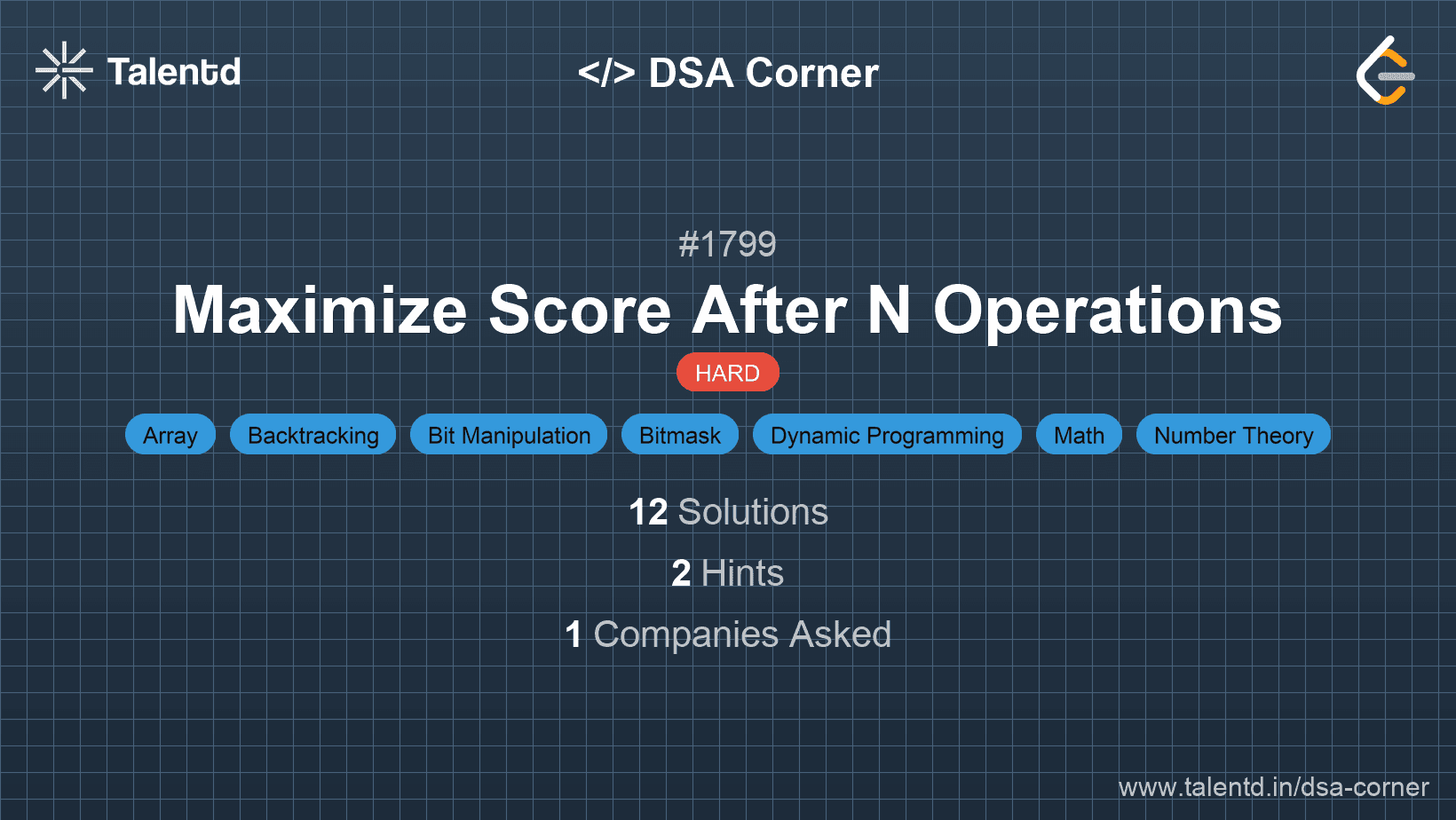
Sponsored
Sponsored
This approach uses backtracking to explore all possible pairs of elements for the operations. The goal is to maximize the sum of scores obtained from each operation. To optimize the solution, pruning is applied by avoiding redundant calculations using a memoization table. By systematically trying all combinations, we gradually eliminate suboptimal solutions and select the maximal score possible.
Time Complexity: O((2n)! / 2^n), the approach explores all possible combinations of pairs.
Space Complexity: O(2^n), for memoization array to store intermediate results.
1#include <stdio.h>
2#include <stdlib.h>
3
4int gcd(int a, int b) {
5 while (b != 0) {
6 int temp = b;
7 b = a % b;
8 a = temp;
9 }
10 return a;
11}
12
13void backtrack(int* nums, int n, int used, int current_score, int* max_score, int* memo) {
14 if (used == (1 << n) - 1) {
15 if (current_score > *max_score) {
16 *max_score = current_score;
17 }
18 return;
19 }
20 if (memo[used] >= current_score) {
21 return;
22 }
23 memo[used] = current_score;
24
25 for (int i = 0; i < n; ++i) {
26 if (!(used & (1 << i))) {
27 for (int j = i + 1; j < n; ++j) {
28 if (!(used & (1 << j))) {
29 int pairScore = gcd(nums[i], nums[j]) * (__builtin_popcount(used) / 2 + 1);
30 backtrack(nums, n, used | (1 << i) | (1 << j), current_score + pairScore, max_score, memo);
31 }
32 }
33 }
34 }
35}
36
37int maxScore(int* nums, int numsSize) {
38 int* memo = (int*)calloc(1 << numsSize, sizeof(int));
39 int max_score = 0;
40 backtrack(nums, numsSize / 2, 0, 0, &max_score, memo);
41 free(memo);
42 return max_score;
43}
44
45int main() {
46 int nums[] = {1, 2, 3, 4, 5, 6};
47 int result = maxScore(nums, 6);
48 printf("Max Score: %d\n", result);
49 return 0;
50}This C implementation uses bit manipulation to keep track of used numbers and compute GCD pairs selectively. The recursive function 'backtrack' explores all pairs of elements, marking them as used and calculating their scores. The result is updated if a higher score is found. Memoization is added to store intermediate results to prevent recalculations.
This approach leverages dynamic programming along with bit masking to compute the maximum score possible. The idea is to use a DP state to remember the best score possible with a certain combination of pairs already taken. The state is determined by a bitmask which indicates the taken pairs. Recursively calculate the maximum possible score, storing intermediate results to avoid repeated calculations.
Time Complexity: O(n^2 * 2^n), where n is the number of elements in 'nums'.
Space Complexity: O(2^n) for the DP array.
#include <vector>
#include <cmath>
using namespace std;
int gcd(int a, int b) {
while (b != 0) {
int temp = b;
b = a % b;
a = temp;
}
return a;
}
int maxScore(vector<int>& nums) {
int n = nums.size() / 2;
vector<int> dp(1 << nums.size(), INT_MIN);
dp[0] = 0;
for (int mask = 0; mask < (1 << nums.size()); ++mask) {
int ops = __builtin_popcount(mask) / 2 + 1;
for (int i = 0; i < nums.size(); ++i) {
if ((mask & (1 << i)) == 0) {
for (int j = i + 1; j < nums.size(); ++j) {
if ((mask & (1 << j)) == 0) {
int new_mask = mask | (1 << i) | (1 << j);
dp[new_mask] = max(dp[new_mask], dp[mask] + ops * gcd(nums[i], nums[j]));
}
}
}
}
}
return dp[(1 << nums.size()) - 1];
}
int main() {
vector<int> nums = {1, 2, 3, 4, 5, 6};
cout << "Max Score: " << maxScore(nums) << endl;
return 0;
}C++ implementation uses a vector to dynamically store scores associated with each possible mask (combination of used pairs). It's systematically updated with combinations providing the best scores through iteration.